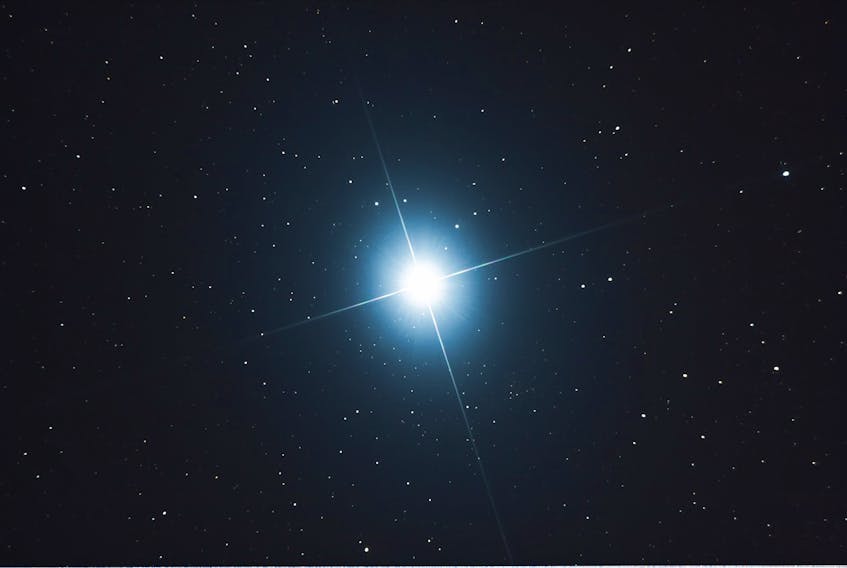Many people think Polaris, the North Star, in Ursa Minor (the Little Bear) is the brightest star in the night sky in the northern hemisphere. However, the brightest is actually Sirius (magnitude -1.46) in the constellation of Canis Major (Latin for "the Great Dog").

Canis Major is prominent in the night sky in winter, and is, along with the constellation of Canis Minor ("the Lesser Dog"), said to represent the two hunting dogs that accompany Orion - the Hunter in his travels across the sky. Sirius (from the ancient Greek for "glowing"), at only 8.6 light years distance, is one of Earth's nearest stellar neighbours.
In Greek mythology, Sirius was Laelaps, a dog given to the princess Europa by Zeus during his seduction of her. It is sometimes referred to as the "dog star" and, to the ancient Greeks and Romans, was associated with the onset of summer's long periods of heat, drought, and sudden thunderstorms; they also associated it with fever, mad dogs and bad luck. Modern day hot summer weather, particularly in August, is often referred to as the "dog days of summer."
Sirius was a very important star to the ancient Egyptians (who associated it with Isis, their goddess of fertility and motherhood), as its rising above the eastern horizon before sunrise (known as a "helical rising") coincided with the flooding of the Nile River, allowing them time to move their animals and temporary structures away from the river's banks. The ancient Polynesians used Sirius as a reference star in their navigation around the Pacific Ocean.
Canis Major also contains two other unique stars. Adhara (Epsilon Canis Majoris) is the brightest known source of ultraviolet radiation. VY Canis Majoris is one of the most luminous and largest known red hypergiant stars (1,420 times the radius of our sun). It is so big that a starship travelling at the speed of light (approximately 300,000 kilometres per second) would take six hours to travel around the star's circumference (as opposed to only 14.5 seconds around our sun).
The second hunting dog, Canis Minor, was added to Orion's hunting party by the ancient Romans. Its brightest star, Procyon (from ancient Greek meaning "before the dog"), has an apparent magnitude of +0.34, and is the eighth brightest star in the night sky. Located approximately 11.46 light years away, it has a mass of about three times that of our sun and is 250 times as luminous.
In Greek mythology, Procyon is associated with Maera, a hound belonging to Erigone, daughter of Icarius of Athens. According to the myth, Icarius, a follower of Dionysus, the Greek god of wine, was slain by a bunch of drunken shepherds. In her despair, Erigone hung herself and Maera leapt off a cliff. Dionysus punished the city of Athens with a plague, which only ended when the surviving residents performed honorific rites for Icarius and Erigone. Dionysus placed the figures of Icarius and Erigone in the night sky as the constellations of Bootes and Virgo (respectively), and Maera as the star Procyon.
Due to Procyon's higher declination (position north or south of the celestial equator) in the night sky relative to that of Sirius, Procyon appears before Sirius in the night sky (thus the "before the dog" nomenclature). Along with Sirius and Betelgeuse (in Orion), Procyon is one of the three vertices (point where two lines meet to form an angle) of the Winter Triangle asterism.
Venus is visible in the early evening sky, appearing in the southwestern sky at dusk around 5 p.m., before setting by 8 p.m. Mars appears in the pre-dawn sky about 16 degrees (a hand-and-a-half width at arm's length) above the southeastern horizon, and remains visible until lost in the rising sun's glow around 7 a.m.
Look for the waning crescent moon just to the upper right of Mars on the morning of Jan. 20, and to the Red Planet's lower left on Jan. 21. Remember to look for the red star Antares (in Scorpius) to the lower right of Mars on these mornings.
Mercury and Jupiter are both still too close to the sun to be seen. Likewise, Saturn, having just reached superior conjunction (passing behind the sun as seen from Earth) on Jan. 13, remains too close to the Sun to be visible at present.
Until next time, clear skies.
Events:
Jan. 24 - New Moon
Glenn K. Roberts lives in Stratford, P.E.I., and has been an avid amateur astronomer since he was a small child. He welcomes comments from readers, and anyone who would like to do so is encouraged to email him at [email protected].









